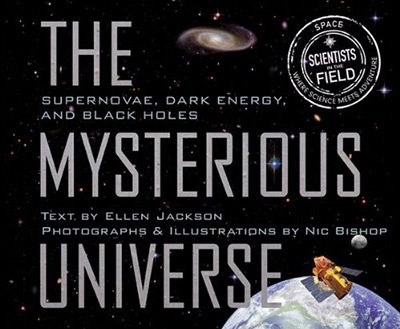Category: Children’s Book
Reviewed by: Susan Raizer
Title: The Mysterious Universe: Supernovae, Dark Energy and Black Holes
Author: Ellen Jackson
Graphics: Nic Bishop
Ages: 8-12
NSS Amazon link for this book
Format: Hardcover
Pages: 60
Publisher: Houghton Mifflin
Date: May, 2008
Retail Price: $18.00
ISBN: 0618563253
What is the best way to learn about supernovae, dark energy and black holes? By following astronomer Alex Filippenko and his High-Z Supernova Search Team as they investigate these phenomena. This book, which is another entry in the Scientists in the Field series, does just that.
Ellen Jackson is an award winning author of more than fifty fiction and non-fiction children’s books who has combined her life long love of science and astronomy with her experience in teaching to provide her young readers with a clear understanding of astronomy. Nic Bishop, with a doctorate in biology, has provided photographs and graphics to enhance the reader’s understanding of the subject.
The concepts presented in this book might seem too sophisticated and complicated for the 8 to 12 year old reader. This is not the case. The presentation captured this reviewer’s interest and introduced me to new material in a friendly easy-to-follow style. For example, the book clearly explains that once astronomers decide what they want to observe, the telescope’s programmers must build a metal ‘mask’ with slits in it which will only let in the light of the object under observation. If the mask is not cut properly, the wrong area of the sky will be highlighted and that night’s observations will be lost. Another interesting fact is that supernovae can only be observed when the Moon is below the horizon, and the sky is really dark.
To get a better understanding of cosmic events, the author followed astronomer Dr. Filippenko, aka “Dr. Alex,” to the W M Keck Observatory located on top of a mountain in Hawaii.
Dr. Alex is an award winning professor of Astronomy at the University of California, Berkeley and a world-renowned expert on supernovae. He is often featured on Discovery Channel and other science media explaining in layman’s terms the intricacies of these astronomical events. He has received many awards including the Carl Sagan Prize for Scientific Popularization. His High Z Supernovae Search team has determined that supernovae are moving away from each other.
At the Keck Observatory, Dr. Alex and his assistant view the sky without the interference of artificial lights. The book opens with the team set up to view two potential supernovae. A supernova is an explosion that occurs at the end of a star’s life cycle which may have occurred millions or billions of years ago. Not all stars go out so dramatically, but when they do, and can be documented by astronomers, they provide evidence about the expansion of our universe. These supernovae explosions also provide the basic elements that are the building blocks of life on Earth.
The reader also learns that by studying supernovae, scientists have also discovered that there is ‘dark energy’ in the universe. This dark energy, which cannot be seen, is apparently helping the universe expand. Another corollary to the study of supernovae is the study of black holes, which are so dense that light cannot escape from them.
Throughout the book, the author offers sidebar explanations of terms that might be unfamiliar to the reader. For example, Dr. Alex must look for a guide star to assist in pointing the telescope to the proper area of the sky. A guide star is a bright star that will point to the right spot. Another example is an explanation of how a spectrum divides light into different colors. Scientists use a spectrograph to determine the temperature and composition of light of objects they are studying. The spectrum illustration is provided in a way that any reader will understand. Other examples include explanations of standard candles and red shift.
Magnificent photographs and illustrations truly capture the subject matter, such as a spectacular photograph of the Crab Nebula and a drawing of a neutron star in size relationship to a white dwarf star and the Earth.
The style is easy to read and easy to understand. By strategically placing actual photographs of cosmic phenomena alongside the written explanations, the reader has a clear understanding of the concept. The photographs are visually pleasing and the reader is not aware of the amount of information they are learning in the process. The charts, graphs and visualizations also aid in understanding. A glossary of terms, bibliography, and index are included.
I would recommend this book to parents and teachers of children in the targeted age group. It is an excellent resource to study supernovae, black holes, and dark energy as well as learning how astronomers perform their research. For members of the National Space Society, a book that captures the imagination of young readers is important to insure that future generations will have a deeper understanding and appreciation of space and astronomy.
© 2009 Susan Raizer
Please use the NSS Amazon Link for all your book and other purchases. It helps NSS and does not cost you a cent! Bookmark this link for ALL your Amazon shopping!



















